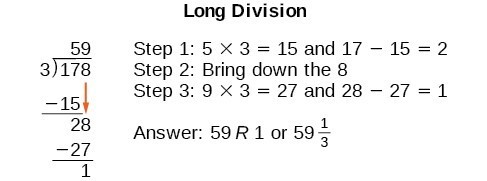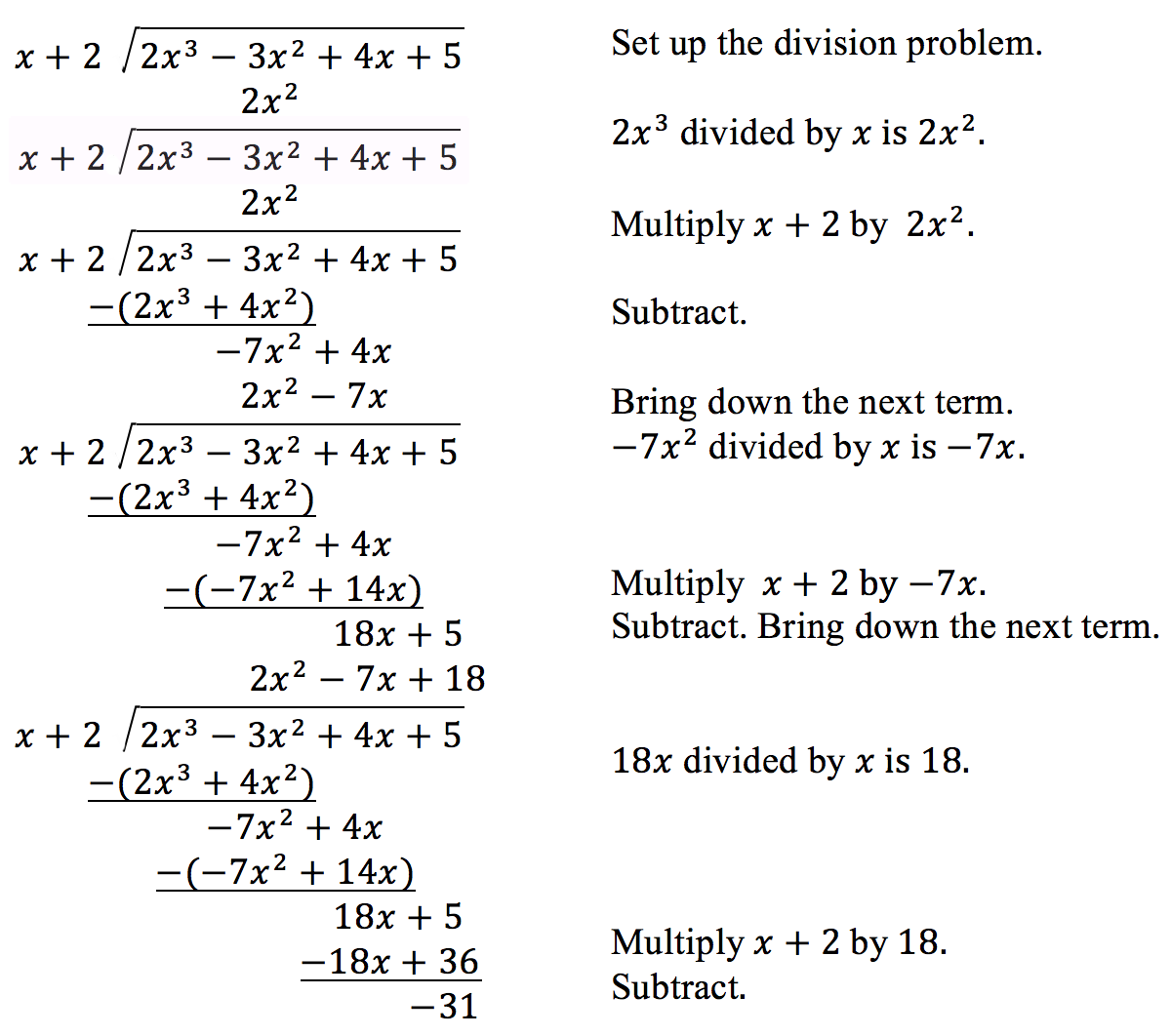Divide Polynomials
The exterior of the Lincoln Memorial in Washington, D.C., is a large rectangular solid with length 61.5 meters (m), width 40 m, and height 30 m.[footnote]National Park Service. "Lincoln Memorial Building Statistics." http://www.nps.gov/linc/historyculture/lincoln-memorial-building-statistics.htm. Accessed 4/3/2014[/footnote] We can easily find the volume using elementary geometry.So the volume is 73,800 cubic meters . Suppose we knew the volume, length, and width. We could divide to find the height.
As we can confirm from the dimensions above, the height is 30 m. We can use similar methods to find any of the missing dimensions. We can also use the same method if any or all of the measurements contain variable expressions. For example, suppose the volume of a rectangular solid is given by the polynomial . The length of the solid is given by 3x; the width is given by . To find the height of the solid, we can use polynomial division, which is the focus of this section.
 Lincoln Memorial, Washington, D.C. (credit: Ron Cogswell, Flickr)
Lincoln Memorial, Washington, D.C. (credit: Ron Cogswell, Flickr)Polynomial Long Division
We are familiar with the long division algorithm for ordinary arithmetic. We begin by dividing into the digits of the dividend that have the greatest place value. We divide, multiply, subtract, include the digit in the next place value position, and repeat. For example, let’s divide 178 by 3 using long division. Another way to look at the solution is as a sum of parts. This should look familiar, since it is the same method used to check division in elementary arithmetic.
Another way to look at the solution is as a sum of parts. This should look familiar, since it is the same method used to check division in elementary arithmetic.
We call this the Division Algorithm and will discuss it more formally after looking at an example. Division of polynomials that contain more than one term has similarities to long division of whole numbers. We can write a polynomial dividend as the product of the divisor and the quotient added to the remainder. The terms of the polynomial division correspond to the digits (and place values) of the whole number division. This method allows us to divide two polynomials. For example, if we were to divide by using the long division algorithm, it would look like this:
 We have found
We have found
or
We can identify the dividend, the divisor, the quotient, and the remainder.
 Writing the result in this manner illustrates the Division Algorithm.
Writing the result in this manner illustrates the Division Algorithm.
A General Note: The Division Algorithm
The Division Algorithm states that, given a polynomial dividend and a non-zero polynomial divisor where the degree of is less than or equal to the degree of , there exist unique polynomials and such thatis the quotient and is the remainder. The remainder is either equal to zero or has degree strictly less than . If , then divides evenly into . This means that, in this case, both and are factors of .
How To: Given a polynomial and a binomial, use long division to divide the polynomial by the binomial.
- Set up the division problem.
- Determine the first term of the quotient by dividing the leading term of the dividend by the leading term of the divisor.
- Multiply the answer by the divisor and write it below the like terms of the dividend.
- Subtract the bottom binomial from the top binomial.
- Bring down the next term of the dividend.
- Repeat steps 2–5 until reaching the last term of the dividend.
- If the remainder is non-zero, express as a fraction using the divisor as the denominator.
Example: Using Long Division to Divide a Second-Degree Polynomial
Divide by .Answer:
 The quotient is . The remainder is 0. We write the result as
The quotient is . The remainder is 0. We write the result as
or
Analysis of the Solution
This division problem had a remainder of 0. This tells us that the dividend is divided evenly by the divisor, and that the divisor is a factor of the dividend.Example: Using Long Division to Divide a Third-Degree Polynomial
Divide by .Answer:
 There is a remainder of 1. We can express the result as:
There is a remainder of 1. We can express the result as:
Analysis of the Solution
We can check our work by using the Division Algorithm to rewrite the solution. Then multiply. Notice, as we write our result,- the dividend is
- the divisor is
- the quotient is
- the remainder is 1
Try It
Divide by .Answer:
Example: Using Polynomial Division in an Application Problem
The volume of a rectangular solid is given by the polynomial . The length of the solid is given by 3x and the width is given by x – 2. Find the height of the solid.Answer:
There are a few ways to approach this problem. We need to divide the expression for the volume of the solid by the expressions for the length and width. Let us create a sketch.
 We can now write an equation by substituting the known values into the formula for the volume of a rectangular solid.
We can now write an equation by substituting the known values into the formula for the volume of a rectangular solid.
To solve for h, first divide both sides by 3x.
Now solve for h using synthetic division.
 The quotient is and the remainder is 0. The height of the solid is .
The quotient is and the remainder is 0. The height of the solid is .
Try It
The area of a rectangle is given by . The width of the rectangle is given by x + 6. Find an expression for the length of the rectangle.Answer:
Key Equations
| Division Algorithm | where |
Key Concepts
- Polynomial long division can be used to divide a polynomial by any polynomial with equal or lower degree.
- The Division Algorithm tells us that a polynomial dividend can be written as the product of the divisor and the quotient added to the remainder.
- Synthetic division is a shortcut that can be used to divide a polynomial by a binomial in the form x – k.
- Polynomial division can be used to solve application problems, including area and volume.
